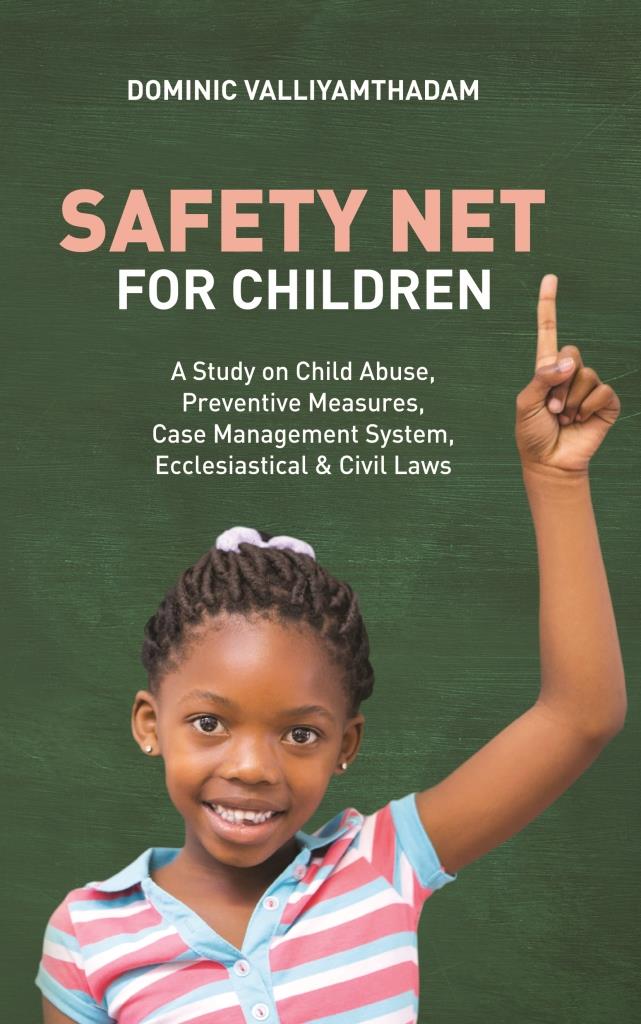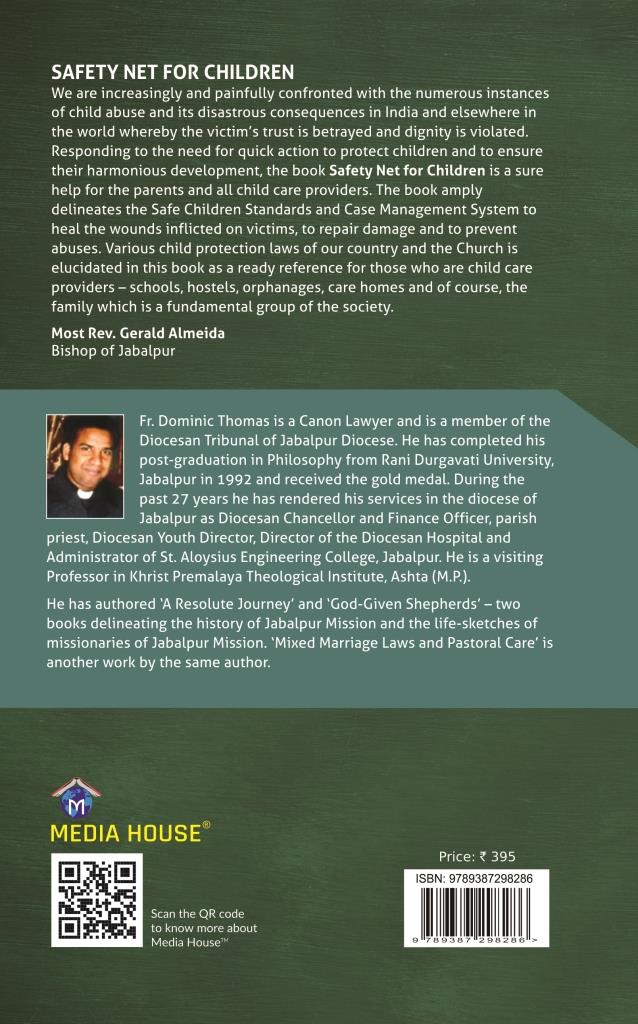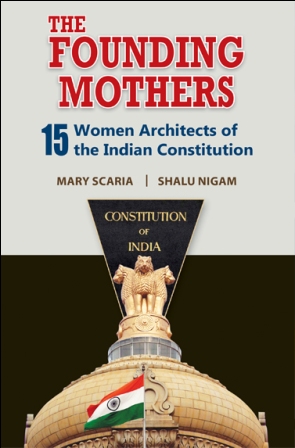Description
ABOUT THE BOOK
We are increasingly and painfully confronted with the numerous instances of child abuse and its disastrous consequences in India and elsewhere in the world whereby the victim’s trust is betrayed and dignity is violated. Responding to the need for quick action to protect children and to ensure their harmonious development, the book Safety Net for Children is a sure help for the parents and all child care providers. The book amply delineates the Safe Children Standards and Case Management System to heal the wounds inflicted on victims, to repair damage and to prevent abuses. Various child protection laws of our country and the Church is elucidated in this book as a ready reference for those who are child care providers — schools, hostels, orphanages, care homes and of course, the family which is a fundamental group of the society.
Most Rev. Gerald Almeida
Bishop of Jabalpur
ABOUT THE AUTHOR
Fr. Dominic Thomas is a Canon Lawyer and is a member of the Diocesan Tribunal of Jabalpur Diocese. He has completed his post-graduation in Philosophy from Rani Durgavati University, Jabalpur in 1992 and received the gold medal. During the past 27 years he has rendered his services in the diocese of Jabalpur as Diocesan Chancellor and Finance Officer, parish priest, Diocesan Youth Director, Director of the Diocesan Hospital and Administrator of St. Aloysius Engineering College, Jabalpur. He is a visiting
Professor in Khrist Premalaya Theological Institute, Ashta (M.P.).
He has authored ‘A Resolute Journey’ and ‘God-Given Shepherds’ — two books delineating the history of Jabalpur Mission and the life-sketches of missionaries of Jabalpur Mission. ‘Mixed Marriage Laws and Pastoral Care’ is another work by the same author.
TABLE OF CONTENTS
PREFACE
FOREWORD
ABBREVIATIONS
Chapter 1
Scenario of Violence Against Children
1.1 Global scenario of Child abuse
1.2 Indian Scenario of Child Abuse
1.3 United Nations Convention on the Rights ofthe Child (UNCRC) 1989
Chapter 2
Child Abuse and Neglect
2.1 Definitions
2.2 Types of Child Abuse
2.2.1 Physical abuse
2.2.2 Sexual abuse
2.2.3 Neglect or Negligent Treatment
2.2.4 Emotional Abuse
2.2.5 Commercial or other exploitation of Children
2.3 Abuse of Disabled Children
2.4 Other forms of Child Abuse
2.4.1 Internet abuse and abusive images of children
2.4.2 Abuse linked to belief in ‘possession’, ‘witchcraft’or related to spiritual or religious beliefs
2.4.3 Spiritual Abuse
2.4.4 Abuse of trust
2.5 ChildAbuses and Protection in a multi-cultural
context
2.5.1 Child Trafficking
2.5.2 Female Genital Mutilation (FGM)
2.5.3 Forced Marriage
2.5.4 Honour Based Violence
2.5.5 Other Abuses
2.6 Factors leading to child abuse
2.7 Child Endangerment
2.8 Beware of ‘child groomers’ – Know the Signs
Chapter 3
Child Protection Safety Net and children Safe Standards
3.1 Child Protection Safety Net or initiatives
3.2 Awareness Building and Sensitization
3.3 Children Safe Standards
3.3.1 Child Protection Policy
3.3.1.1 Aims of Child Protection Policy
3.3.1.2 Characteristics of Child Protection Policy
3.3.1.3 Elements of a Child Protection Policy
3.3.2 Risk Management
3.3.3 Code of Conduct
3.3.4 Standards for Recruitment and selection
3.3.4.1 Designing the Job and Job description
3.3.4.2 Selection Process
3.3.4.3 References and Checks
Checklist For Recruitment and Selection
3.3.5 Training and Educating Staff and Volunteers
3.3.6 ReportingChild Abuse
3.3.6.1 Barriers to Reporting
3.3.6.2 Child Abuse Identification
3.3.6.3 What to do if someone tells you he/she has been abused
3.3.6.4 Recording of Information
3.3.6.5 Community Responsibility in Reporting
3.3.6.6 Mandatory Reporting
3.4 Key Principles in Child Protection and WelfarePractices
3.5 Tips for Parents and Care Providers to
safeguard children’s safety
Chapter 4
Case Management System
4.1 Standards and Procedures:
4.2 Phases of Case Management System
4.3 Types of Case Management System
4.3.1 Cases involving a staff/member (insider) asalleged offender
4.3.2 Case Management System where a non-member
of the organization (outsider) is involved inthe child abuse case
4.4 Providing Protection, Medical and Psychological
help to the affected child
4.5 Responding to a child who discloses child abuse
4.6 Confidentiality issues
4.7 Protecting the rights of the alleged perpetratoroffender
Chapter 5
Ecclesiastical Laws for Child Protection
5.1 Church’s commitment to address the problem
of Child Abuse adequately
5.2 Ecclesiastical laws in Historical Perspective
5.3 Motu Proprio“Sacramentorum Sanctitat is Tutela” (2001)
5.4 Revision of “Sacramentorum Sanctitat is Tutela” (2010)
5.5 Ecclesiastical Laws on other types ofchild abuses
Chapter 6
Child Protection Laws in India
6.1 Child Rights and Protection in IndianConstitution
6.2 Legislative Acts
6.2.1 The Factories Act, 1948
6.2.2 The Mines Act, 1952
6.2.3 The Child Labour (Prohibition and Regulation)Act, 1986
6.2.4 The Conception and Prenatal DiagnosticTechniques (Prohibition of Sex Selection) Act,
2002
6.2.5 The Prohibition of Child Marriage Act, 2006
6.2.6 Right of Children to Free and Compulsory
Education Act, 2009
6.2.7 Protection of Children from Sexual Offences
Act 2012 (POCSO Act, 2012)
6.2.8 The Juvenile Justice (Care and Protection ofChildren) Act, 2015
6.3 Laws related to Children in Indian PenalCode (IPC)
6.4 Laws related to Children in Criminal ProcedureCode (Cr. PC)
6.5 Nirbhaya Case: A Turning Point in JuvenileOffences
6.6 Criminal Law (Amendment) Ordinance, 2018
Chapter 7
Child Protection Policy
1 Introduction
2 Administrative Systems and Officers
3 Preventive Strategies within the Diocese
4 Standards for Human Resouse
5 Case Management System
6 Communication about/to Children
7 Child protection in emergencies
8 Training Evaluation and Monitoring
9 Revision of Child Protection Policy
10 Decree of Promulgation
11 Declaration of Commitment
Appendix
1. United Nations Convention on the Rights of the Child
2. Guide to Understanding Basic CDF Procedures Concerning
Sexual Abuse Allegations
3. Cbci Procedural Norms for Dealing With Cases Involving
Sexual Abuse of Minors
Bibliography
Index





Reviews
There are no reviews yet.